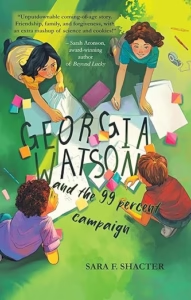Georgia Watson and the 99 Percent Campaign
Sara F. Schacter
Fitzroy Books
Published October 14, 2025
Amazon | Bookshop | Goodreads
About Georgia Watson and the 99 Percent Campaign
After years of moving, Georgia’ s family is staying put. What’ s the best part of her new forever home? Fellow science fan Izzy!
Georgia feels lucky to be starting sixth grade with her first true friend. But when Georgia’ s science project accidentally reveals a secret— one Izzy trusted her to keep— their friendship unravels. Even worse, Georgia’ s archenemy swoops in to steal Izzy away, leaving Georgia cut off and lonely. How can Georgia fix her mess?
She’s surprised to find the answer in a science genetically, all human beings are more than 99 percent the same. Really? Georgia can’ t believe she and the friend-stealer are even 1 percent the same! But as Georgia fights to win Izzy back, she discovers that enemies can struggle with loneliness too— and Georgia is stunned to discover why. It will take a 99 percent campaign to make things right.
My Review
The sticky note campaign in this book reminded me of a nonfiction title I read years ago called I Wish My Teacher Knew by Kyle Schwartz. The campaign in that book wasn’t the same, but the use of sticky notes is similar.
At its heart, this book is about a girl who’s struggling to find her place among her peers. She feels like she only has one friend, and thinks the relationship is threatened when someone else wants to be friends with her bestie. That problem feels pretty real for the age group.
In the story, Georgia also thinks about herself as a scientist, and thinks of that as being really different than both her parents. Her dad is an actor, and her mom is a baker. I like that the story kind of spun that idea around to show how important creativity is to the field of science. It helped Georgia see herself as a creative person, even though her creativity looks different than her parents’.
I also really liked the 99 Percent Campaign. When Georgia learns that humans have more than 99% of their genes in common, it changes how she thinks about her classmates. She begins identifying ways they’re similar rather than focusing on their differences.
I love that lesson, and it certainly resonates as an important reminder for today.
This book will appeal to readers who enjoy books by Gillian McDunn or Kate Messner. It would make a great class read-aloud or book to read with a small group. The group could then recreate the 99 Percent Campaign from the story and note the effects.
Content Notes
Recommended for Ages 8 to 12.
Profanity/Crude Language Content
None.
Romance/Sexual Content
References to a crush.
Spiritual Content
None.
Violent Content
Brief references to adults saying cruel, critical things to their kids. Georgia uses a photo editor to make an unflattering picture of her classmate. A group of boys picks on another boy.
Drug Content
None.
Note: This post contains affiliate links, which do not cost you anything to use but help support this blog. I received a free copy of this book in exchange for my honest review. All opinions are my own.
Marvelous Middle-Grade Monday
I’m sharing this post as a part of a weekly round-up of middle-grade posts called Marvelous Middle-Grade Monday. Check out other blogs with posts about middle-grade books today on Marvelous Middle-Grade Mondays at Always in the Middle.
